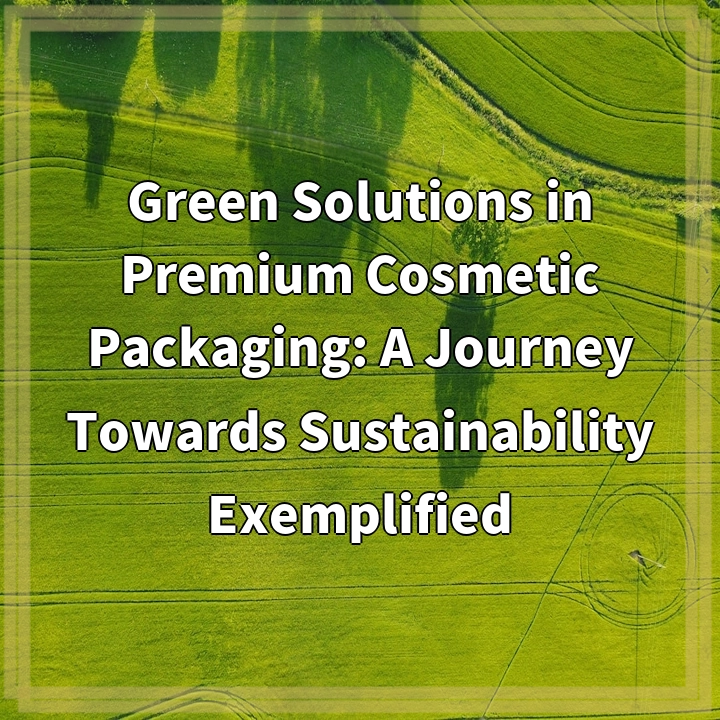
What it is:
Green solutions in premium cosmetic packaging refers to the use of sustainable and eco-friendly materials and practices in the design, production, and disposal of cosmetic packaging. It involves minimizing the environmental impact of packaging while still maintaining its premium quality and aesthetic appeal.
Real-world problems:
The cosmetic industry is known for its excessive use of packaging, which often leads to substantial waste generation and environmental pollution. Some of the key real-world problems associated with conventional cosmetic packaging include:
1. Plastic pollution:
Plastic packaging, particularly single-use plastics like plastic bottles, tubes, and jars, contribute significantly to the global plastic pollution crisis. These plastics take hundreds of years to decompose and often end up polluting water bodies, harming wildlife, and leaching toxic chemicals into the environment.
2. Resource depletion:
Traditional cosmetic packaging relies heavily on the extraction of finite resources, such as fossil fuels for manufacturing plastics and paper for packaging boxes. This puts a strain on natural resources and contributes to deforestation, habitat destruction, and climate change.
3. Carbon footprint:
The production, transportation, and disposal of cosmetic packaging result in greenhouse gas emissions, contributing to climate change. This includes the energy-intensive manufacturing processes, long supply chains, and inefficient waste management practices associated with conventional packaging materials.
4. Lack of recycling and sustainable options:
Many cosmetic packaging materials are not easily recyclable due to complex combinations of materials, mixed compositions, or lack of appropriate recycling facilities. This results in a significant proportion of packaging ending up in landfills or being incinerated, causing further environmental harm.
5. Consumer perception and demand:
Consumers are increasingly concerned about the environmental impact of products, including their packaging. Brands that do not prioritize sustainability in their packaging solutions may face a negative perception from environmentally conscious consumers and may lose out on market share to more eco-friendly competitors.

Solutions to Green Solutions in Premium Cosmetic Packaging:
The challenges associated with conventional cosmetic packaging can be mitigated through various sustainable solutions. These solutions aim to reduce waste, minimize resource consumption, and promote eco-friendly practices throughout the packaging lifecycle.
1. Sustainable materials:
One of the key solutions is to transition from conventional materials, such as plastic, to more sustainable alternatives. This includes using bio-based, biodegradable, or compostable materials for packaging, such as plant-based plastics, recycled paper, glass, or metal. These materials have a lower environmental impact and can be easily recycled or disposed of without causing harm to the environment.
2. Minimalist and efficient design:
Adopting minimalist packaging design can significantly reduce material usage and waste. Streamlined packaging designs with less unnecessary embellishments and excessive layers can contribute to a more sustainable approach. Additionally, optimizing packaging dimensions and weight can reduce transportation emissions and overall resource consumption.
3. Recyclable and reusable packaging:
Promoting recyclability and incorporating recycled content in packaging materials is another important solution. This involves designing packaging that is easily recyclable, such as using mono-materials or materials with compatible recycling streams. Encouraging the use of refillable or reusable packaging options can also reduce waste generation and minimize the need for single-use packaging.
4. Eco-friendly production and supply chain:
Implementing environmentally-friendly practices in the production and supply chain is crucial for sustainable cosmetic packaging. This can include using renewable energy sources, optimizing manufacturing processes to minimize waste and emissions, and sourcing materials from responsible and certified suppliers. Collaborating with suppliers to develop closed-loop systems for material reuse and recycling can also help reduce the environmental footprint.
5. Education and consumer awareness:
Raising awareness among consumers about the importance of sustainable packaging and providing relevant information can drive demand for greener options. Brands can educate consumers through labeling, marketing campaigns, and transparent communication about their packaging choices. Engaging customers in recycling programs and offering incentives for returning packaging can also encourage greater participation in sustainable practices.















